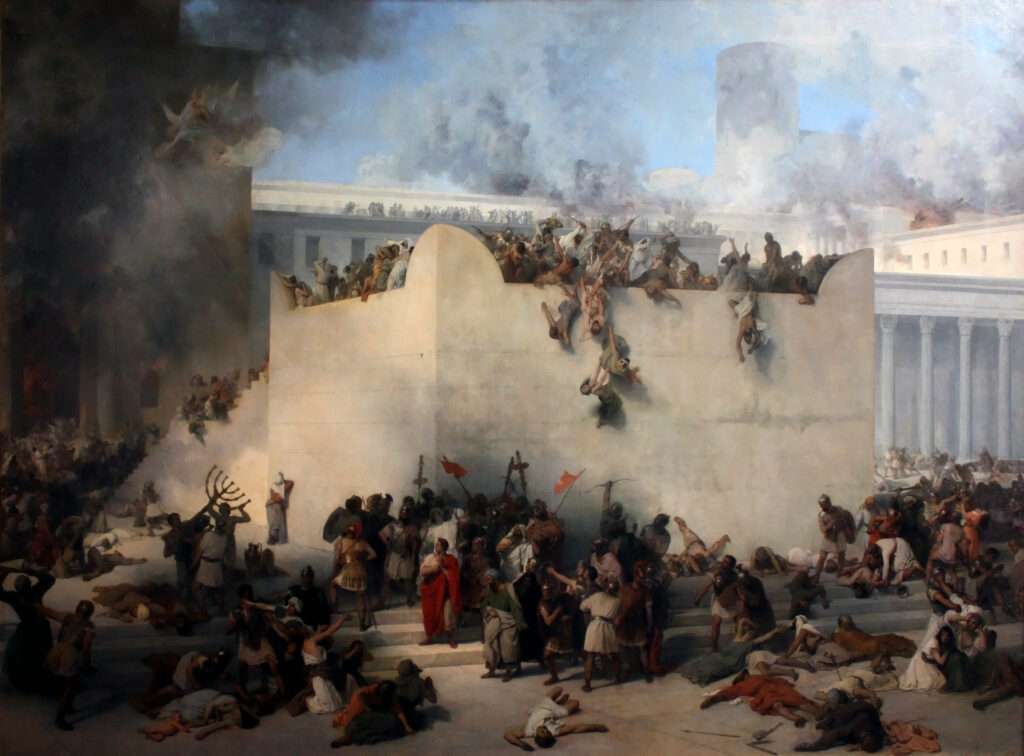The Siege of Jerusalem in AD70

In Jerusalem, even a pile of rocks is significant. Early in 2016, archaeologists working for the Israel Antiquities Authority found heaped up rocks and stones while investigating part of the Russian Compound in central Jerusalem. But, this being Jerusalem, these were stones that told a story of blood and terror, of the gods and God.
In 70AD, the Roman general, Titus, laid seige to Jerusalem. Under his command were four legions – 60,000 men. Inside the city were about half a million Jews, most of whom were families caught in what had become a death trap. Judea had long been a fractious part of the Roman Empire, the unhappiness of its subjects worsened by a series of inept governors. In the chaos that surrounded the final years of the Emperor Nero’s rule and the fighting following his death, the Jews rose in revolt, declaring an independent state with its capital in Jerusalem and its heart in the great Temple. But when Vespasian took control of the Empire he dispatched his son, Titus, to put down the Jewish revolt.
Despite having four years to prepare for the Roman attack, the new Jewish state had squandered energy and manpower in internal fighting. The gangs of three warlords fought through the streets of Jerusalem, even into the Temple itself. But worship and sacrifice nevertheless continued, with hundreds of thousands of pilgrims arriving in Jerusalem to celebrate the Passover in April 70AD. And there they were trapped. Titus invested the city, trapping residents and pilgrims alike.
But the rebels were confident they could withstand the Romans. Jerusalem itself was ringed by walls and watchtowers and, at its centre, the Temple was as much citadel as place of worship. And the rebels had completed the Third Wall, begun by Herod Agrippa in 40, which protected the more vulnerable northern side of the city. We have a witness to what happened next in the appalled and self-exculpatory work of Josephus, one of the leaders of the Jewish revolt who, captured, defected to the Romans and became interpreter to Titus.
Standing beside his master outside Jerusalem, Josephus looked upon a city that held his own parents as well as many friends. It must have looked impregnable. “Many towers, 35 feet high and 35 feet broad, each surmounted with lofty chambers and with great tanks for rain water, guarded the whole circuit of the walls, 90 being in the first wall, 14 in the second, and 60 in the third.”
It was this Third Wall that Titus attacked first. And it’s the debris of this assault that Israeli archaeologists found in the Russian compound, scattered in front of the excavated line of the wall. They found more than 70 ballista stones right in front of the wall. The bombardment was intended to attack the sentries guarding the wall and to provide cover for the Roman forces so they could approach the wall with battering rams and thereby breach the city’s defenses.
They did. But the Jews fought on.
The Romans stormed the second wall, then had to retake it all over again when the Jews counterattacked. Titus invested the city, building a wall around Jerusalem’s walls to seal the inhabitants into their city tomb, and then settled down to let famine do his work. According to Josephus, people walked ‘like shadows, all swollen with famine, and fell down dead…a deep silence and a kind of deadly night seized the city.’ The Romans crucified anyone who attempted to escape, sometimes killing 500 people a day: the Mount of Olives was covered with crosses.
Finally, at the end of July, Titus ordered his legions to make the final attack on the Temple. The defenders fought over every stone, but they were overwhelmed and fire spread in the wake of the blood madness.
The Temple, the seat of God’s presence on earth, burned.
0 Comments